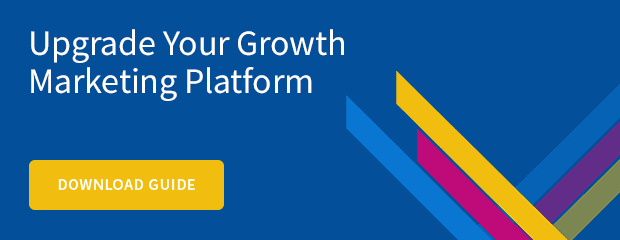If there’s anything that I’ve learned in my six years of selling marketing technology, it’s that marketers who use legacy platforms are stuck.
Whether they’re chained to their developers for even the simplest tasks or drowning in hidden fees, they’re limited—physically, mentally and financially—by these outdated solutions.
It’s important to note that these roadblocks are not unique. It’s not you—it’s them. And when you recognize how your MarTech is holding you back from creating awesome customer experiences, you’ll be on the right track to making a game-changing upgrade.
Here are the four phrases I hear the most when working with prospective clients that reveal they’re on the MarTech struggle bus. I’m here to break it to you now before it’s too late—if you’ve ever said any of these things, then something has gone terribly wrong.
1. “Hold On—Let Me Get My Engineers Involved”
It pains me to hear marketers say they need to engage their CRM or dev teams to extract a complex audience segment. It is soul crushing to hear about requiring dedicated engineering resources for something as simple as an A/B test.
As someone who is not a marketer, take this next part with a grain of salt. Here is what an outsider sees as marketing’s responsibilities:
Not Your Job
- It is not your job to know SQL or AMPscript.
- It is not your job to wait days or even weeks to get a response to your support ticket.
- It is not your job to memorize a data schema.
Your Job
- It is your job to make your company money.
- It is your job to increase your KPI of choice.
- It is your job to test, report, improve, and optimize.
It’s great if you’re already a tech-savvy marketer who can code, but if you are spending your days waiting around for others to get your campaign out the door, then it’s safe to say that something is wrong.
I don’t want to see your spirit pummeled from constantly asking yourself, “Why is this so hard?” or “Why can’t I do this?” It doesn’t have to be so hard, and you shouldn’t have to do it anymore.
2. “We’re Getting Nickeled and Dimed to Death”
Straightforward billing, wouldn’t that be great? Exceeding your budget because of hidden fees or overages just to accomplish your baseline goals is painful in its own right; that pain only gets worse when you have to report this news to your VP, CMO, CEO, or board of directors.
Ballooning costs may not necessarily be the direct fault of the marketer, but if you’re the one responsible for managing the technology, then guess who’s falling on the sword?
SPOILER: It’s you.
Anytime you need to ask for more money to do the bare minimum, ask yourself:
- How much does this request tarnish my reputation?
- How will this affect my career path internally?
- How well can I trust my tools going forward?
Marketers shouldn’t have to work in environments plagued by doubt, fear, and uncertainty.
Looking deeper into this issue, we can identify the questionable billing practices of legacy ESPs as the main culprit behind marketer inefficiencies and rising costs.
Things You Shouldn’t Be Paying For
- API calls
- Projects or software environments
- Setting up DNS
- Users entering journeys
- Too many data points (How are you supposed to get a 360˚ view of your customer?)
Over the years, many vendors theorized that if they could get in the door of different companies, then there was a good chance they could remain there for at least five years—unfortunately, that theory manifested itself into today’s reality.
They recognized early on that the pain of migration was real and something that brands would avoid at all costs—nobody wants to rip and replace such a major tool once it’s up and running.
This paved the way for the nickel and diming scams that we see today. If you are getting hit with bill after bill, then something is definitely wrong. Recognize gambler’s fallacy before it starts—if you’re seeing a lot of rising costs, they won’t be going away.
3. “We Have Spent So Much Already on Our Current ESP”
Where do you stand today? You’ve invested lots of time, resources and money into a tool that is repeatedly failing to deliver the results you want. You’ve tried to make it work, but the costs are rising—the writing is on the wall, friend. It’s time to walk away.
So why haven’t you already?
Mistakes were made. It’s ok—it’s part of growth. In fact, it was most likely the right choice at that time. You’ve made the right choice before. It is up to you and your team to make the right choice for the company’s future.
If your platform isn’t coinciding with your business and revenue goals, you must choose to move on.
I’ve seen companies refuse to pull the plug on a poorly fitting tool simply because they feel they’re too far along into the relationship and cannot walk away from their financial commitment. The hours, dollars, and heartaches have piled up too high for them to see the hard truth.
Struggling to “repair the relationship” with your vendor is the first sign that it is already too late.
The most valid concern under this umbrella is the cost of switching. This is a concern I can get behind.
Luckily, a lot has happened in the last 20 years when it comes to MarTech. Platforms outside of the major players have flexible architecture that’s easy to implement. This allows the dreaded cost of switching to be a fraction of what you can expect with the legacy platforms.
4. “I’m Looking for a One-Stop Shop”
Forbes reported that the modern MarTech stack consists of 16 different tools and platforms. That was over a year ago, so it has probably doubled. Naturally, the idea of consolidating all of those platforms is an enticing one, but there certainly are caveats to consider.
The most glaring issue surfaces the moment you aspire to create anything remotely complex or immersive for your customers. A so-called one-stop shop can offer a lot of coverage in terms of basic abilities but can be self-limiting in depth of capabilities and execution.
Modern platforms, on the other hand, are built to work in complementary fashion inside a larger stack. They are designed with strong and flexible APIs ensuring that your data is transferred without friction between multiple platforms—they actually “speak” to each other in real time.
Data continuity is a requirement when nurturing your prospects into customers.
The days of SFTP and manual export/imports as a step in the creation process are over. In a massive technology market, there’s no reason to limit your marketing potential. You should be in complete control of your MarTech stack and making it flex to meet your specific needs—not the other way around.
The modern marketer is more than capable of wielding an entire stack of best-in-class MarTech solutions. Remember, if you are using a platform that only executes a portion of your desired campaign, in the end, you’re hurting your customer’s experience.
MarTech: Do It Right
The journey inward is the hardest journey one can take. Looking in the mirror is a painful exercise.
Because email is the highest grossing channel, many brands can make money with even the most basic of marketing programs.
Unfortunately, this leads to fewer reviews of strategy and technology. You just operate at status quo until one day you send a press release out talking about turnaround strategies.
Let’s make these minor tweaks while they are still minor. There are companies out there that are happy to help.
Want to learn more? Check out our guide to Upgrading Your Growth Marketing Platform.

































